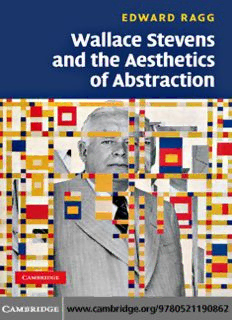
Wallace Stevens and the Aesthetics of Abstraction PDF
Preview Wallace Stevens and the Aesthetics of Abstraction
This page intentionally left blank Wallace StevenS and the aeStheticS of abStraction edward ragg’s study is the first to examine the role of abstraction throughout the work of Wallace Stevens. by tracing the poet’s inter- est in abstraction from Harmonium through to his later works, ragg argues that Stevens only fully appreciated and refined this interest within his later career. ragg’s detailed close-readings highlight the poet’s absorption of late nineteenth-century and early twentieth- century painting, as well as the examples of philosophers and other poets’ work. Wallace Stevens and the Aesthetics of Abstraction will appeal to those studying Stevens as well as anyone interested in the relations between poetry and painting. This valuable study embraces revealing philosophical and artistic perspectives, analysing Stevens’ place within and resistance to Modernist debates concerning litera- ture, painting, representation and ‘the imagination’. edward ragg is a poet and teaches at tsinghua University, beijing. he is co-editor of Wallace Stevens across the Atlantic (2008). Wallace StevenS and the aeStheticS of abStr action edWard r agg Tsinghua University, Beijing CAMBRIDGE UNIVERSITY PRESS Cambridge, New York, Melbourne, Madrid, Cape Town, Singapore, São Paulo, Delhi, Dubai, Tokyo Cambridge University Press The Edinburgh Building, Cambridge CB2 8RU, UK Published in the United States of America by Cambridge University Press, New York www.cambridge.org Information on this title: www.cambridge.org/9780521190862 © Edward Ragg 2010 This publication is in copyright. Subject to statutory exception and to the provision of relevant collective licensing agreements, no reproduction of any part may take place without the written permission of Cambridge University Press. First published in print format 2010 ISBN-13 978-0-511-78951-9 eBook (NetLibrary) ISBN-13 978-0-521-19086-2 Hardback Cambridge University Press has no responsibility for the persistence or accuracy of urls for external or third-party internet websites referred to in this publication, and does not guarantee that any content on such websites is, or will remain, accurate or appropriate. The poet striding among the cigar stores, ryan’s lunch, hatters, insurance and medicines, denies that abstraction is a vice except to the fatuous. These are his infernal walls, a space of stone, of inexplicable base and peaks outsoaring possible adjectives. one man, the idea of man, that is the space, The true abstract in which he promenades. from ‘a Thought revolved’ (1936), Wallace Stevens Contents Acknowledgements page ix List of Abbreviations x introduction: ‘Stevensian’ and the question of abstraction 1935–2009 1 1 The abstract impulse: from anecdote to ‘new romantic’ in Harmonium (1923) and Ideas of Order (1935) 30 2 The turn to abstraction: Owl’s Clover (1936) and the ‘un-locatable’ speaker in The Man with the Blue Guitar (1937) 55 3 The ‘in-visible’ abstract: Stevens’ idealism from coleridge to Merleau-Ponty 78 3.1 romantic adaptations: Wordsworth, coleridge, Stevens 78 3.2 abstract analogues: blanchot, Merleau-Ponty, Stevens 88 3.3 The touch of henri focillon 101 3.4 coda: the new criticism and abstraction 107 4 abstract figures: the curious case of the idealist ‘i’ 110 4.1 taming ‘the guerrilla i’: the early poems of Parts of a World (1942) 110 4.2 from ‘robust poet’ to idealist ‘i’: ‘The noble rider and the Sound of Words’ (1942) and ‘The figure of the Youth as virile Poet’ (1943) 119 4.3 The human abstract in ‘landscape with boat’ (1940) 129 5 abstract appetites: food, wine and the idealist ‘i’ 136 5.1 tasting ‘certain Phenomena of Sound’ (1942) 136 5.2 hartford bourguignon: ‘Montrachet-le-Jardin’ (1942) and Cymbeline 143 vii Contents viii 6 The pure good of theory: a new abstract emphasis 166 6.1 ‘Major man’ revised: ‘Paisant chronicle’ (1945) and ‘description Without Place’ (1945) 166 6.2 Writing ‘beyond’: ‘repetitions of a Young captain’ (1944) and ‘Three academic Pieces’ (1947) 174 6.3 Pragmatic abstraction v. metaphor: ‘The Pure good of Theory’ (1945) and Macbeth 185 7 bourgeois abstraction: poetry, painting and the idea of mastery in late Stevens 204 7.1 Mastery of life: at home with Wallace Stevens 204 7.2 conclusion 228 Bibliography 232 Index 244
Description: